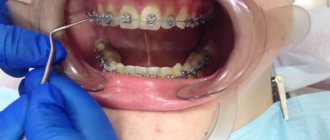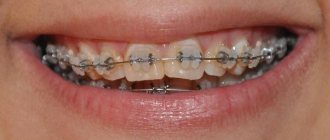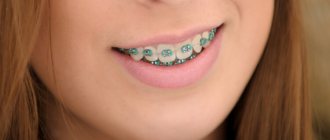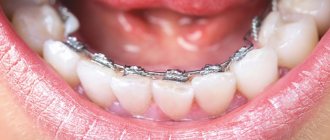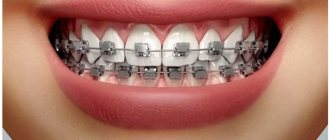11021
A beautiful smile is something that many people dream of for many years, or even their entire adult life.
However, the cost of correcting malocclusion using braces may exceed the financial capabilities of many patients.
The article will provide examples of the possibility of free bite correction, as well as methods of treatment at minimal cost.
Preparation
Before installing braces, you need to do three things: put fillings, take a panoramic photo of the jaw and remove teeth as prescribed by the orthodontist.
Fillings can be placed in any clinic, regardless of where your orthodontist sees you. You can treat your teeth before visiting the orthodontist; in any case, this will have to be done before installing braces. If dental care is included in your work health insurance, get it covered.
You will need an image of the jaw - also known as an orthopantomogram - in any case. It is convenient to do it in advance, before you go to the orthodontist. The photo costs about one and a half thousand rubles, it can also be done in any clinic. An orthopantomogram is usually not included in insurance.
The reality of free orthodontic treatment
In Russia, the list of services paid for through the compulsory medical insurance policy does not include the alignment of teeth and the correction of malocclusions with a braces system.
This rule applies to most policy owners. Their desire to have straight and beautiful teeth is only possible through their own financial resources.
But there are exceptions to this provision. Certain categories of citizens have been identified who have the right to receive benefits or have braces installed absolutely free of charge.
First of all, this applies to children in difficult life situations, more specifically:
- orphans;
- left without parental care;
- with maxillofacial defects;
- with disabilities due to any disease.
In addition, children whose families have little material income have the right to assistance in paying for such services from the state.
For adults, there are also several options for exposing the device free of charge. They may be:
- The need for placement arose due to a medical error or failure to provide timely assistance to the person by the clinic staff.
But in this situation, fixing the defect will not be completely free. The fact of damage caused as a result of the doctor’s inaction/action will need to be proven in court, which means incurring material costs for the trial. - Work under an employment contract, which provides for a clause on reimbursement by the employer for the services of an orthodontist or dentist.
- Public people whose activities involve constant contact, or whose appearance indirectly or directly affects their work.
For example, an employee is a representative of a well-known brand or large company. Then the employer pays all costs for the correction and correction of defects in the dentofacial apparatus. But it’s clear that in order to receive such a bonus at work, you have to be a truly valuable employee. - Pensioners receiving a minimum pension. The condition for this option is medical indications that it is mandatory to install braces (for example, in case of serious gastrointestinal diseases).
- Disabled people receiving benefits from the state for their disability.
If a person does not fall under one of the categories listed above, he will have to pay for the treatment of pathologies of the dental system and for corrective construction.
To use one of these options, you need to study the legal intricacies of this process. A lawyer will help you take into account all the features and avoid mistakes.
The patient will need to go through various authorities and submit documents confirming his physical, financial and marital status (or other), which can be decisive in the issue of free orthodontic care.
Orthodontic services under the compulsory medical insurance policy for children
Children are the majority of orthodontic patients, since bite problems most often arise in childhood. What free services can you count on?
Article on the topic: Methods and forms of protecting the rights of insured citizens in the compulsory medical insurance system
The list of free services for children within the framework of compulsory medical insurance includes:
- orthodontist appointment;
- correction of bite using orthodontic plates;
- removable prosthetics;
- massage;
- repair and correction of orthodontic plates;
- Help with painful teething in babies.
It should be noted that the plates are made only from domestic material. The installation of imported dental structures is not provided for under compulsory medical insurance.
It is necessary to correct the bite in children as early as possible. Then it is possible to do without braces and use the services of an orthodontist under the compulsory medical insurance program.
Video on the topic of the article
Installation of braces
So, you have cured your teeth, taken a picture, chosen an orthodontist and removed any extra teeth, if any.
After this, an impression of your teeth will be made. Using it, the doctor models a treatment regimen. A cast costs 2.5-3 thousand rubles. At the end of treatment, the impression is usually returned to the patient as a keepsake.
My cast: left as a keepsake
After this, you will be given a date for installing braces. Braces are the main expense when straightening teeth.
You will need to install two braces: for the upper and lower jaw. A single bracket system is not installed: it is believed that treatment should be comprehensive and correct the entire bite. Therefore, it will not be possible to correct curvature, for example, only in the lower jaw.
At first, braces will be placed on only one jaw, usually the upper jaw. In a couple of months you will get used to the braces, and the doctor will look at your progress and how your teeth move. At this time, you will wear the thinnest archwire. After this, braces will be placed on the lower jaw.
The most common types of braces in Russia are metal, ceramic, sapphire and lingual.
Ceramic braces match the color of tooth enamel, so they are practically invisible on the teeth. But it is believed that they are less effective than metal ones - you will have to wear them longer. And they cost more. Another disadvantage: light ceramic ligatures are stained. Therefore, doctors recommend not drinking red wine, strong black tea, or eating beets if you wear ceramic braces. One arc of ceramic braces in 2020 cost me 40 thousand rubles.
We suggest you read: How much can you drink ketorol for toothache?
Sapphire braces are made from artificial crystal, completely transparent, and expensive. One arc costs from 50 thousand rubles.
Lingual braces are another type of braces system. This arch is installed on the back side of the teeth, so they are completely invisible to others. Lingual braces make your mouth smaller, so you may develop a lisp. Lingual braces are the most expensive option. One arc costs from 70 thousand rubles.
You can combine different types of braces: for example, put ceramic ones on the upper jaw, and iron ones on the lower jaw, which is less visible. I did so.
The photo was taken on the last day of wearing braces.
There are ceramic braces on the upper jaw and metal braces on the lower jaw. Payments are made differently in different clinics. I know that some dentists ask you to pay for the entire complex treatment at once. I paid in stages, after each brace system was installed and after each visit to the orthodontist.
Equipment does not count
Braces are a device, not a treatment.
You will not be given a tax deduction for their cost. The final stage is removing braces, ordering aligners and cleaning your teeth.
Removing braces takes about an hour. I paid 7 thousand for withdrawal.
On the same day, teeth are usually cleaned using the Airflow apparatus. Cleaning after wearing braces is considered mandatory: you need to clean all the places that have been covered by the braces system for a year or more. Airflow costs 3-5 thousand rubles. In 2013, I paid 1,500 rubles for this procedure because there was a promotion at my clinic.
Airflow cleaning is often included in VHI at work, if dentistry is included in it. You can usually do cleaning with this program once every six months. Check your insurance.
After removing braces, there will be another major expense - aligners. They are needed so that the teeth do not move apart again in different directions when the doctor removes the arches.
Mouthguards are made individually, based on a cast. The wearing period is determined by the orthodontist. You will need to wear the mouthguards every night - just put them on and go to bed.
The mouth guards cost me 5,600 rubles: 2,800 per mouth guard for one jaw.
- Ask about the promotions that are taking place at the clinic - maybe you are suitable for them.
- Pay by card - get cashback if you have a Tinkoff Bank card. In general, always pay with a Tinkoff Bank card.
- Metal braces are significantly cheaper and move your teeth faster—meaning you'll need fewer visits to the orthodontist. It’s also metal in a smile - what could be better than metal in a smile?
- The cost of braces and dental services in large cities is much higher than in small cities. If you want to save money, find a clinic in another city where the same treatment will be cheaper. But be prepared to go there every month.
- The bracket may break. Be prepared to rush to the clinic if something happens.
- Russia loves it when you correct your bite with braces. Collect documents and receive a tax deduction - 13% of the cost of medical procedures.
At what age do children get braces?
Dentists do not have a common view on this issue. Some orthodontists are confident that from the age of 7-8 years it is already possible to begin bite correction with a brace system. The main thing is that by this age the child’s second molars have fully erupted, the teeth are of sufficient length to attach the bracket, and the enamel has good strength. Other orthodontists categorically do not install dental braces before the age of 13.
So when should you put braces on your child? Most experts agree that it is closer to adolescence. It is important to take into account the individual characteristics of a particular patient, the number of crooked teeth, the degree of malocclusion, the strength of the enamel and many other factors. When a child gets braces too early, there is a risk of damage to tooth enamel, root resorption, and even loss of permanent teeth. Therefore, when asked at what age it is better to install braces, most doctors answer - at 13-14 years old. After installation, you can wear braces until you are 18 years old. This age period is considered the most optimal for bite correction. On the one hand, teeth are pliable and easy to straighten. On the other hand, tooth enamel is strong enough to withstand the heavy load of the orthodontic apparatus.
Possibility of minimal costs
There are several ways to correct the bite and straighten individual dental elements with minimal material resources.
The search for solutions should be directed not at state medical institutions, but at private ones. Only in them there are different options for paying for treatment at a price significantly lower than the fixed one.
Here are a few ways to get braces virtually free:
- Profitable promotions.
Quite often, dental clinics (especially those that have just opened) conduct advertising campaigns for their services to attract customers. Their conditions vary, but usually the patient pays for the course of treatment, and the device is given as a gift. In this situation, the total price of treatment is reduced by 1/3, sometimes even by 1/2. - Checking a new batch of products.
This is when a certain modification of braces has been tested by the manufacturer, but is unfamiliar to a particular institution. To find out their characteristics, test them in use and monitor the dynamics of treatment, volunteers are being recruited for testing. Then the patient receives a significant discount or a free system with mandatory payment for its placement and maintenance. - Testing a new type of braces. This option is rare, because Usually the manufacturer supplies tested orthodontic products to clinics.
But if this option occurs, the person receives the corrective structure free of charge, as a fee for the tester’s work.Since the process is fraught with certain difficulties and risks, one must be aware of the possible consequences of such a step. By approving a contract to test an unfamiliar system, the patient takes a certain risk.
- Accumulative and bonus systems.
Most medical institutions have this practice. In an attempt to attract clients, special programs are being developed. Regular customers are issued discount cards that work on a cumulative basis. Having accumulated a certain amount on it, the patient can pay for the service, including the placement of the device.
Important! In public clinics, such options are not provided; bite correction and teeth straightening are carried out on a paid basis. At the same time, the cost is slightly lower than in private clinics, and the choice of devices is limited.
We invite you to read: Viburkol suppositories for teething children - how to use, instructions, reviews
Braces under compulsory medical insurance – is it possible to correct a bite under an insurance policy?
6344
A beautiful smile is something that many people dream of for many years, or even their entire adult life.
However, the cost of correcting malocclusion using braces may exceed the financial capabilities of many patients.
The article will provide examples of the possibility of free bite correction, as well as methods of treatment at minimal cost.
The reality of free installation
It should be noted right away that bite correction is not included in the health insurance policy in the Russian Federation.
Accordingly, neither adults nor children have the right to free installation of braces or visits to the orthodontist.
There are, however, several exceptions to this statement. First of all, these are children from privileged categories of the population:
- orphans;
- children with congenital jaw pathology;
- disabled children.
In addition, free installation of braces can be carried out in cases where the patient’s bite pathology appeared as a result of a medical error.
However, it is difficult to call this procedure completely free - the fact of damage as a result of the doctor’s action or inaction will have to be proven in court, and therefore, the costs of litigation will have to be borne.
Public people can also count on free installation of braces. If the patient is the face of a large company or brand, then the employer whose interests he represents may well act as a sponsor for the procedure to correct the bite.
If the patient does not fall into any of the above categories, do not despair.
Installing braces for free or at minimal cost is still possible, however, this will require some effort.
Possibility of minimal spending
There are several ways to correct your bite with minimal investment in treatment. In this case, the direction of searches should be turned from public to private clinics.
It is there that there are various options for paying for treatment at a price significantly lower than the fixed one:
- The first way to save is through profitable promotions.
Regarding braces, there is a widespread practice of holding a promotion, during which the client pays in full for the bite correction course, and receives the brace system itself for free. The total cost of treatment becomes less by a third, or even half of the total amount. - Another way is to test new products.
Such chances don’t come along very often, and in order not to miss them, you will have to very carefully follow the news from various clinics and manufacturers. The idea is that the manufacturer recruits a group of volunteers to test new products.Since the procedure is associated with certain risks, testing the product is absolutely free for the patient.
In addition, in the event of the development of adverse symptoms and poor-quality treatment, the brand may not bear any responsibility. Also, the patient will have to visit the doctor more often than usual so that he can compile reports on the progress of testing the product.
- Another way, similar to the previous option, is to participate in testing new batches of goods for the clinic.
In this case, we are talking about the fact that a manufacturer has been producing a product that has passed testing for a long time, but a clinic has only recently signed a contract to cooperate with it.The patient is given either a significant discount or free braces, but with payment for installation and maintenance during treatment. In any case, such chances also come infrequently and require careful monitoring of various social networks, etc.
- Another common way to save is by having savings and bonus systems.
This practice exists in many private dental clinics. If you have been a client of a clinic for a long time, you can enjoy large discounts and sometimes even free services.Some clinics issue unnamed discount cards, so you can use one that belongs to a friend or relative.
In public clinics, as a rule, there is no such practice of rewarding regular clients. At the same time, prices for treatment may be slightly lower, however, the choice of products and additional services there is usually small.
The video provides additional information on the topic of the article.
Mandatory expenses
Despite the fact that the above were ways to save money and even get braces for free, a patient who wants to correct his bite still faces mandatory expenses prior to the installation procedure.
First of all, this is payment for the initial consultation of the orthodontist. At the initial consultation, the oral cavity is examined and a treatment strategy is drawn up - the type of bite and problematic dental units whose position needs to be changed are determined.
During the initial consultation, the orthodontist invites the patient to choose a specific type of braces system, taking into account his wishes and financial capabilities, and, if possible, offers alternative treatment methods.
After the doctor has established the need for treatment, the diagnostic stage . An x-ray is taken to better understand the position of the teeth and the structure of the jaws. If necessary, the doctor prescribes a number of other tests (in particular, if the patient has inflammatory processes or other diseases of the oral cavity).
It should be kept in mind that braces can only be installed on healthy teeth.
Therefore, if the patient has carious cavities, inflammation of soft or bone tissue, then all these diseases must first be cured.
Also, based on preliminary diagnosis, the doctor may decide to remove some dental units (for example, if the patient has a small jaw, but large teeth - when correcting the bite in such a situation, some dental units simply will not be able to “fall into place”).
To properly install the system, an impression is taken from the patient’s jaw and a plaster model is made to understand the required angle and force of impact. Immediately before installation, the patient needs to undergo hygienic cleaning of the oral cavity .
During treatment, the patient will also need to visit the doctor several times to adjust the teeth alignment process and prevent possible complications.
When using self-ligating braces, such visits occur a little less often, and with ligature braces - a little more often.
Nuances of saving
There are some principles that will allow the patient to save some money on installing braces:
- Search for dental clinics that have only recently started operating.
Such centers, as a rule, organize various promotions, provide free diagnostics, and also offer their first customers a discount card. This policy allows newly opened clinics to quickly gain a client base. - Another way is to look for advertisements for promotions and coupons.
If the patient has a particular clinic in mind, you can follow them on social networks. They usually publish the latest information about discounts, as well as partner promotions. - It is also worth keeping in mind that saving means choosing cheaper materials.
Regarding braces, it will cost significantly less to install models made of non-precious alloys than samples made of titanium, sapphire or ceramics. - The type of braces also significantly affects the final cost of treatment.
Vestibular models, which we are used to thinking of when we hear the word “braces,” will cost the patient much less than lingual models, which are worn hidden, since they are located on the lingual part of the dentition.
conclusions
So, if the patient does not belong to the category of beneficiaries and is not a media person whose producer is willing to pay for the beauty of his smile, there are still many ways for him to save on bite correction. However, each method of pursuing profit is fraught with serious risks.
For example, choosing a clinic that has recently opened its doors carries the risk of encountering unqualified specialists or low-quality equipment.
You will not find reviews of these clinics about their work, so carefully consider seeking help from such places. Study the documentation, certificates, pay attention to the sterility of the instruments in the office.
The choice of cheap materials threatens to cause an allergic reaction - many people are intolerant to alloys containing chromium and nickel. In addition, metal alloys look much less aesthetically pleasing than ceramics or sapphire.
The same problem with choosing a vestibular system - if you are not ready to walk with a metal structure on your teeth for about two years, think about what you are saving on your comfort and self-confidence.
Moreover, it is worth mentioning the testing of new products. The installation of experimental samples is carefully regulated only by large brands with high responsibility , which, as a rule, do not need to recruit volunteers “from the street”.
Many less responsible manufacturers save on insurance by forcing the patient to sign papers of voluntary consent and waiver of claims as a result of poor-quality treatment.
One way or another, each patient independently decides whether to choose one or another method of saving or abandon it. The article is intended only to highlight existing ways to reduce the cost of malocclusion treatment, and the priorities of finance or health remain a personal matter for each individual reader.
, please select a piece of text and press Ctrl+Enter.
Source: https://orto-info.ru/sistemyi-vyiravnivaniya-zubov/breketyi/po-oms-mozhno-li-ispravit-prikus.html
Scheduled visits to the orthodontist
Further expenses are usually less than the cost of braces, and are even more extended over time.
Every month you need to come to the orthodontist for a scheduled appointment. The orthodontist evaluates the progress, makes a lift or changes the arches (for example, installs a tighter arch). A scheduled appointment with an orthodontist costs an average of 2,000 rubles. In 2013, I paid 1,500 rubles every month for a regular appointment.
Sometimes the doctor may prescribe additional procedures and devices, for example:
- wear elastic bands that tighten the upper and lower jaw;
- install a spring that accelerates the movement of teeth in the jaw;
- place the screw on the tooth;
- install the Herbst apparatus.
The Herbst apparatus corrects the position of the jaws relative to each other.
It is placed when one of the jaws is pushed forward. Due to all these prescriptions, the cost of treatment may vary. They put a spring on me and told me to wear rubber bands. The spring cost 3,000 rubles, and the elastic bands cost 100 rubles per package, which lasted for two months. A friend of mine was fitted with a Herbst apparatus. She wore it for six months and paid 40 thousand rubles.
Unscheduled visits
One day my brace broke. I unsuccessfully bit off a steel chain, and the “lock” to which the arch is attached flew off the tooth. The next day I went to the doctor. I thought that I would have to pay a large sum for restoration, but it turned out that this is a typical breakdown for everyone who wears braces. The replacement cost me 500 rubles.
Mandatory expenses
Despite the existence of real savings options when installing braces, any patient will face expenses that will have to be paid.
First of all, this is the fee for the initial consultation with the orthodontist. At the first visit, the doctor examines the oral cavity, assesses the condition of the dentofacial apparatus, paying special attention to the type of bite and the correct location of the dental elements.
Based on the results of the examination, a treatment protocol is drawn up. Then the specialist, together with the client, selects a suitable brace design, based on the complexity of the defect and the latter’s financial capabilities.
After establishing the fact of the need for treatment, the diagnostic stage begins. To better understand the position of individual teeth, the condition and structure of the jaws, radiography is performed.
If necessary, the orthodontist prescribes other examinations and tests (for example, if periodontal inflammation or other pathologies of the oral cavity are detected).
You must understand that installing a braces system is only possible on healthy teeth. Therefore, if the examination reveals caries, inflammation or other problems, a full treatment course is carried out.
During the development of treatment tactics, the doctor may decide to extract certain elements. For example, if a person with large dental units has insufficient jaw parameters.
In this situation, crooked teeth will not be able to align due to lack of space on the jaw arch, and removing one or two is the only way to make room for the rest.
To place the devices at the required angle and correctly calculate the force of the entire structure, an impression is taken from the patient’s jaws and a plaster model is made. Hygienic cleaning is also a mandatory preparatory procedure.
The client's costs do not end there. After installing the device, he will have to periodically visit a doctor throughout the treatment period to monitor the process and prevent complications, which is also a paid service.
You will also have to pay for the removal of the structure upon completion of treatment.
It is also necessary to take into account such a nuance as the time the system remains in the mouth. Usually it is 1.5-2 years. During this period, an unexpected situation may arise:
- arc deformation;
- loss of adhesive properties;
- tooth injury, etc.
Each such case will require the intervention of an orthodontist to eliminate the problems that have arisen and, accordingly, a separate fee.
Life after removing the braces will also require financial expenses, but not as significant as before and during treatment.
To maintain the result of the correction, you will need to use special devices - mouth guards or retainers. The duration of wearing is determined by the doctor on an individual basis.
The nuances of installing braces under compulsory medical insurance
774
Being the owner of an even row of beautiful teeth is the desire of most modern people. But nature has not given such a gift to everyone.
In addition, bite alignment is quite a costly endeavor.
There are ways to correct this flaw for free, or by significantly reducing financial losses. This opportunity is provided by a compulsory health insurance policy (CHI).
Possibility of minimal costs
People who have set out to have straight teeth should know a few more nuances that relate mainly to private clinics.
They also give you the opportunity to get braces for free. Such cases include:
- Carrying out promotions . Often clinics (especially newly opened ones) hold various advertised promotions for their services to increase their client base. The conditions for their implementation are different, including completely free installation of braces.
- Trial batch for a specific clinic. This is the case when a certain type of brace systems has already been tested in use, but is unfamiliar to this institution. To determine their characteristics and effectiveness, the clinic (by agreement with the manufacturer) conducts a series of trial procedures free of charge for the client.
- Bonus systems. Many private clinics, wanting to “attach” regular clients to themselves, are developing various bonus programs. As a rule, they have a cumulative principle. Namely: when the payment for the services of this clinic reaches a certain amount, free installation of braces is a bonus for the patient.
- Testing a new type of brace systems for yourself. This option is quite rare. Typically, all manufacturers supply already tested models to medical institutions.
But rare cases of such deliveries can still be found. Then the patient receives the brace system free of charge, as a fee for the work performed by the tester.
Attention! The patient must be clearly aware of the consequences of such a step. By agreeing to test an unfamiliar design or materials, he is taking a certain risk.
Of course, identifying opportunities to obtain inexpensive braces requires certain costs (time and effort). But the game is worth the candle - in the end the patient will have straight teeth, received for free.
Mandatory expenses
Listed above are the options for getting braces for free. However, unfortunately, nothing is completely free (except for a mousetrap). Therefore, even if the patient falls under any of these cases, he still faces certain expenses.
Before installing braces, he must independently finance the following steps:
- Preliminary consultation with a dentist and orthodontist.
- Diagnostics. Here the possibility of setting up this system in principle is determined; existing diseases of teeth and gums are identified; a further treatment plan is determined.
- Removal of teeth as prescribed by a doctor (if necessary).
- Treatment of current dental diseases.
- If necessary, tooth filling.
The patient should also be aware that installation, maintenance and removal of the braces system are subject to payment.
One should not miss such nuances as the period of stay of the system in the oral cavity. It is usually a year or more. During this time, a variety of situations can occur - damage to the braces, tooth injury or another unforeseen event. Each of them requires specialist intervention.
The further life of an even dentition also requires financial costs (but they are not large compared to those already made).
To consolidate and maintain the results obtained, the patient is recommended to use special devices - retainers, mouth guards (also not free). The duration and periods of wearing them are prescribed by the orthodontist, individually in each specific case.
Nuances of saving
If it was not possible to get braces for free, there are options to reduce the cost of the main treatment period.
If you have an existing problem, you must first contact a newly opened dental clinic. There is a high probability that in the first months of work there they will adhere to a loyal financial policy.
Since the service of installing braces is in demand today, in order to attract clients in new centers, its cost will be almost symbolic.
There are other ways to save:
- Provide a budget but reliable design. These include metal products, provided there is no allergy to the material. In addition, the main treatment period is short, which means you will rarely have to visit the orthodontist.
- Choose a self-regulating system. Tracking its performance does not require frequent visits to the doctor. And considering that you have to pay for each visit, such a system ends up being more economical.
- Refuse computer modeling. As practice shows, in many situations this service can be neglected. Experienced specialists will correctly install the device without modeling, taking into account all the features of the clinical case.
- Wait for the promotion. Clinics periodically hold promotional campaigns based on manufacturers’ suggestions. When conducting them, you don’t need to hope for a free service, but getting a decent discount is possible.
- Get a tax deduction. You can take advantage of the benefit by submitting all relevant documents to the tax service.
- Install vestibular braces. These models cost much less than lingual types. The only drawback is that it is difficult to hide when talking and smiling.
- Take a loan. Sometimes this is a smart decision. Even though the overall costs will be higher in the end, you can install the most optimal model. Moreover, payments will be spread out over time, which will be less painful for the family budget.
We suggest you read: Dry mouth after alcohol
The above-mentioned methods of saving do not require much effort from a person today. It is enough to search for the necessary information on the Internet and in the press, and consult with a specialist.
The video provides additional information on the topic of the article.
How to get braces for free
It is almost impossible to get braces for free in Russian clinics. This procedure is not included in the register of compulsory health insurance services. But there are certain categories of beneficiaries and opportunities to reduce the cost of orthodontic treatment.
Is it possible to install braces for free under the compulsory medical insurance policy?
Installation of braces is not included in the list of free dental services for children provided for in compulsory medical insurance. But the following measures can be taken for categories of beneficiaries:
- orthodontic examination;
- treatment of anomalies of the dentofacial apparatus;
- retention measures.
The following persons fall into the category of beneficiaries:
- children from large families;
- orphans and teenagers raised and studying in boarding schools;
- children born with congenital pathologies of the maxillofacial apparatus.
Such children have the right to have free braces installed, provided that their parents and guardians collect the necessary package of documents. Treatment in this case will be carried out in state dentistry using domestic metal systems.
On a note!
Adults are not eligible for the benefits listed above. But they can count on free installation of braces in a public clinic under one circumstance: the doctors are proven guilty of mistakes made on their part in relation to the patient’s dental system, which led to certain complications.
Is it possible to install braces for free under VHI?
The VHI policy does not include consultations and installation of braces with an orthodontist in the standard insurance package, since visits to a specialist and bite correction are expensive and are required for a long period of time.
The basic VHI package for dental services includes the following:
- consultations with a dentist, periodontist, surgeon;
- diagnostic procedures;
- treatment of caries and pulpitis, tooth filling;
- preventive measures (professional hygiene, etc.);
- X-ray visualization;
- opening of an abscess, enucleation of a cyst, tooth extraction;
- anesthesia during treatment and extraction of teeth;
- emergency care in case of acute pain;
- some physiotherapy.
Important!
The VHI policy does not cover services for orthodontics, prosthetics and transplantology. Therefore, it is impossible to install braces under the compulsory medical insurance and voluntary medical insurance policy if the person does not fall under the category of beneficiaries.
How to save on installing braces
There are ways that can help significantly reduce the cost of orthodontic treatment, regardless of benefits or age of the patient. They are available in private dental clinics. But finding such an opportunity will require some effort. These options include:
- Stock. Some clinics offer various discounts in an attempt to attract patients. When carrying out such promotions, for example, “Refer a Friend”, treatment and installation of braces will cost much less. Savings and bonus programs are possible.
- Participation in testing. A rare chance to get braces for free. It can be obtained in the case of the release of new products on the dental market, which are subject to testing regarding effectiveness and safety and are supplied to clinics free of charge. The disadvantage of this method is that they install braces, the effectiveness of which has not yet been proven.
- Trial braces. Sometimes the manufacturer offers dental centers free models of previously tested products. This practice is carried out if the clinic has not previously collaborated with this manufacturer. In this case, braces will be free, but you will have to pay for the remaining stages - diagnostics, installation, maintenance and removal of systems.
- Tax deduction. A good opportunity to return part of the money spent for the therapy. Every Russian taxpayer can count on a 13% deduction. Payments can be received by collecting the relevant documents confirming the costs of therapy and contacting the Federal Tax Service at your place of registration or work. Parents receive a tax deduction for their child.
Bottom line
You cannot get braces under compulsory medical insurance if a person does not fall into the category of beneficiaries. Real advice is to take advantage of the terms of bonus programs and promotions, pay attention to the installation of trial products, and collect documents for tax deductions. With some effort, it is quite possible to save money on correcting your bite with less loss for the family budget.
( 1 rating, average 5 out of 5 )
Source: https://jsmiles.ru/ortodontiya/8-brekety/207-postavit-besplatno/
How to save money on braces
- Ask about the promotions that are taking place at the clinic - maybe you are suitable for them.
- Pay by card - get cashback if you have a Tinkoff Bank card. In general, always pay with a Tinkoff Bank card.
- Metal braces are significantly cheaper and move your teeth faster—meaning you'll need fewer visits to the orthodontist. It’s also metal in a smile - what could be better than metal in a smile?
- The cost of braces and dental services in large cities is much higher than in small cities. If you want to save money, find a clinic in another city where the same treatment will be cheaper. But be prepared to go there every month.
- The bracket may break. Be prepared to rush to the clinic if something happens.
- Russia loves it when you correct your bite with braces. Collect documents and receive a tax deduction - 13% of the cost of medical procedures.

